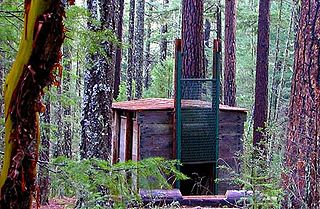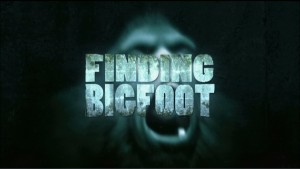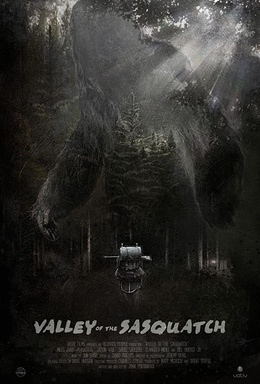
Bigfoot, also commonly referred to as Sasquatch, is a large, hairy mythical creature said to inhabit forests in North America, particularly in the Pacific Northwest. Bigfoot is featured in both American and Canadian folklore, and since the mid-20th century has grown into a cultural icon, permeating popular culture and becoming the subject of its own distinct subculture.

The Patterson–Gimlin film is an American short motion picture of an unidentified subject that the filmmakers have said was a Bigfoot. The footage was shot in 1967 in Northern California, and has since been subjected to many attempts to authenticate or debunk it.

The Yeti is an ape-like creature purported to inhabit the Himalayan mountain range in Asia. In Western popular culture, the creature is commonly referred to as the Abominable Snowman. Many dubious articles have been offered in an attempt to prove the existence of the Yeti, including anecdotal visual sightings, disputed video recordings, photographs, and plaster casts of large footprints. Some of these are speculated or known to be hoaxes.

Grover Sanders Krantz was an American anthropologist and cryptozoologist; he was one of few scientists not only to research Bigfoot, but also to express his belief in the animal's existence. Throughout his professional career, Krantz authored more than 60 academic articles and 10 books on human evolution, and conducted field research in Europe, China, and Java.
The Skookum cast is a plaster cast showing the imprint of what appears to be a large animal. It was discovered in a muddy wallow near Mount Adams in the southern part of Washington state in the year 2000. Enthusiasts have argued that the imprint may have been made by the mythical creature, Bigfoot, though scientific analysis says it was most likely an imprint of an elk. Scholars and academics consider Bigfoot, and alleged evidence, to be a combination of folklore, misidentification, and hoax rather than a living animal.

The Legend of Boggy Creek is a 1972 American docudrama horror film about the "Fouke Monster", a Bigfoot-like cryptid reportedly seen in and around Fouke, Arkansas, since the 1940s. The film combines staged interviews with local residents who claim to have encountered the creature, along with reenactments of these encounters. Director and producer Charles B. Pierce, an advertising salesman, secured funding from a local trucking company and hired local high school students to help complete the film. Made on a budget of $160,000, the film was released theatrically on August 8, 1972.
In Arkansas folklore, the Fouke Monster, also known as the Boggy Creek Monster and the Swamp Stalker, is purported to be a humanoid creature, similar to descriptions of Bigfoot, that was allegedly sighted in the rural town of Fouke, Arkansas during the early 1970s. The creature was alleged to have attacked a local family. It has since become a part of Arkansas folklore. Stories of the creature influenced the 1972 docudrama horror film The Legend of Boggy Creek, which became the 11th highest-grossing film of 1972 and is today considered to be a cult classic.

Bossburg is a ghost town in Stevens County, Washington, and is located on the east bank of the Columbia River just south of the Canada–US border. Bossburg had a maximum population of 800 in 1892. The town was once named "Young America," although in 1896 it was renamed in honor of the town's first citizen, C. S. Boss. It is currently best known for the 1969 discovery of the footprints in the snow of a supposed Sasquatch known as "Cripplefoot," and subsequent hi-jinks.
Raymond L. Wallace was an American amateur Bigfoot hoaxer.

The Bigfoot trap is located in the Rogue River–Siskiyou National Forest in the southern part of Jackson County, Oregon, 3.1 miles (5.0 km) from the California border. Believed to be the only one of its kind, the trap was designed in 1974 to capture Bigfoot, a purported ape-like creature said to live in the forests of the Pacific Northwest. It failed to accomplish this, and was abandoned in the early 1980s.

Bigfoot is a 1970 independently made American low budget science fiction film, produced by Anthony Cardoza and directed by Robert F. Slatzer. The film stars or co-stars a few well-known actors : John Carradine, Chris Mitchum, Joi Lansing, Ken Maynard, Doodles Weaver, and Lindsay Crosby.
Bigfoot is an alleged human or ape-like cryptid in North America. Since the mid-20th century, Bigfoot has become increasingly relevant in popular culture and is the subject of film, television, advertising, music, literature and more.

Finding Bigfoot is an American reality television series on Animal Planet that follows a team of four researchers investigating potential evidence for Bigfoot, a human or ape-like mythical creature alleged by some to inhabit the North American wilderness. Despite the team never capturing conclusive evidence for Bigfoot's existence and mixed reviews from critics, the show gained high ratings and was a top earner for Animal Planet. It premiered on May 29, 2011, and the series finale and 100th episode was released on May 27, 2018; one special episode released in 2021.

The Legend of Bigfoot is a 1976 American pseudo-documentary film directed by Harry Winer.

Valley of the Sasquatch is a 2015 American horror film written and directed by John Portanova and starring Miles Joris-Peyrafitte, Jason Vail, David Saucedo, D'Angelo Midili, and Bill Oberst Jr. as a group of hunters who encounter a family of Sasquatches. It premiered in February 2015 at the Nevermore Film Festival.

Bigfoot: The Life and Times of a Legend is a non-fiction book written by Joshua Blu Buhs and published in 2009 by the University of Chicago Press. It explores the history of the concept of Bigfoot, discusses the exploits of its believers, as well as hoaxers, and examines the cultural influences that give the entity its staying power.
"Big Feet" is the 21st episode of the supernatural drama television series Grimm of season 1, which premiered on May 11, 2012, on NBC. The episode was written by Richard Hatem from a story by Alan DiFiore and Dan E. Fesman, and was directed by Omar Madha.

Big Legend is a 2018 independent monster horror film released in 2018 by Sony Pictures Home Entertainment. It follows an army veteran who returns to search the Pacific Northwest forest where his fiancé was taken by a legendary creature.
Hoax [aka Bigfoot] is a 2019 American horror film directed by Matt Allen, starring Cheryl Texiera, Ben Browder and Hutch Dano.












